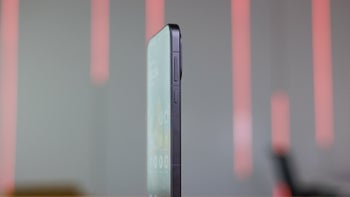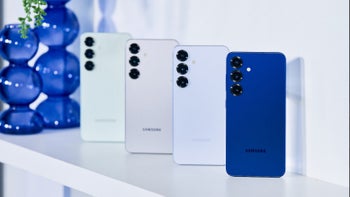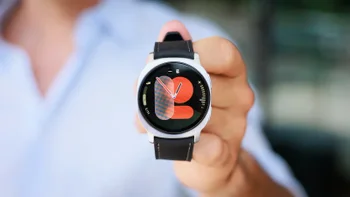LG G3 vs HTC One (M8): first look
Design
The G3 builds on LG's penchant for good screen-to-body ratio, as it fits the 5.5" display diagonal in a body as big as the 5.2" Z2. With the 5" One (M8), however, HTC went for the long and narrow form, which is much more palm-friendly than the wide G3 (70.6mm vs 74.6). As usual, HTC has created a bold and characteristic design that cannot be easily mistaken. What's more, HTC's phone is undeniably premium, due to its usage of high-quality materials and a rather solid build, though a tad heftier than the G3. However, it is one unibody piece of crafted aluminum, whereas the metallic-looking back cover of the G3 is removable, so you can easily swap the battery if needed.
Unfortunately, HTC has gone for a top-placed lock key, which makes you stretch all the way up the tall handset to lock the display, whereas the G3 keeps up with the G2 tradition, with a conveniently located rear lock key and volume rocker. Thus, the G3 design might be less manageable with one hand, due to the wider chassis, but in other aspects its design is more flexible, and let's not forget we are talking a 5.5" display here, against the 5" panel of the One (M8). HTC's phone, on the other hand, sports a dual stereo speaker set at the front, which makes a perfect use of the comparatively tall body - a feature that the G3 doesn't sport.
We said that the LG G3 is a bit wider than the One (M8), but it more than makes up for it by sporting a noticeably larger screen.The G3 packs a 5.5" panel, while the One has the still-sizable 5" display. LG one-upped every major phone manufacturer with a Quad HD 1440x2560 pixels display, however, as that kind of resolution ensures incredibly high pixel density and image clarity. Even at 5.5", the G3 display still sports the record for a smartphone 538ppi pixel density. Still, the One (M8)'s 1080p panel is looking fine and detailed more than enough, ready to take on any definition test thrown at it, unless you are talking about 2K movies in their native resolution, which is a rather unlikely scenario. The IPS-LCD display of the G3 seems to be a great one when it comes to color representation, and the brightness seems on par with the One (M8), at least during our brief indoor encounter with the handset. The viewing angles are something we can easily observe without any measuring equipment, and they are stellar on both handsets.
The phones come with Android 4.4 KitKat, but each has its own manufacturer overlay with very distinct looks and functions that differ quite a lot. LG has started to take the Optimus UI user interface in the right direction. The custom UI now appears to be somewhat toned down, with flatter design and more regular colors, while at the same time, responsiveness has been taken to a whole new level. The G3 offers unique features like Knock Code, and Sual Windows mode, which comes very handy on the big-screen handset.
On the other hand, HTC's Sense 6 UI that's running on the HTC One has a somewhat more mature look, utilizing some nice textures, and an overall uniform and grown-up approach to the GUI. It's not as feature-rich as the Optimus UI, but does have some pleasant surprises like the BlinkFeed news and social networks aggregator, the Zoe camera collage mode, as well as some custom apps by HTC.
Coming two months later than the HTC One (M8), the G3 still sports the same processor. We've got a 2.3 GHz quad-core Snapdragon 801 in LG's finest, but there's also a version with the slightly faster, 2.5 GHz model, the one you will find in the Samsung Galaxy S5. With an updated Adreno 330 GPU, the phones perform even better than those Snapdragon 800 phones that are already on the market. The One (M8) has paired the processor with 2 GB of RAM, while the G3 has a variant that will come with 3 GB of the good stuff, while both sports microSD cards for storage expansion.
Display
We said that the LG G3 is a bit wider than the One (M8), but it more than makes up for it by sporting a noticeably larger screen.The G3 packs a 5.5" panel, while the One has the still-sizable 5" display. LG one-upped every major phone manufacturer with a Quad HD 1440x2560 pixels display, however, as that kind of resolution ensures incredibly high pixel density and image clarity. Even at 5.5", the G3 display still sports the record for a smartphone 538ppi pixel density. Still, the One (M8)'s 1080p panel is looking fine and detailed more than enough, ready to take on any definition test thrown at it, unless you are talking about 2K movies in their native resolution, which is a rather unlikely scenario. The IPS-LCD display of the G3 seems to be a great one when it comes to color representation, and the brightness seems on par with the One (M8), at least during our brief indoor encounter with the handset. The viewing angles are something we can easily observe without any measuring equipment, and they are stellar on both handsets.
Interface and Functionality
The phones come with Android 4.4 KitKat, but each has its own manufacturer overlay with very distinct looks and functions that differ quite a lot. LG has started to take the Optimus UI user interface in the right direction. The custom UI now appears to be somewhat toned down, with flatter design and more regular colors, while at the same time, responsiveness has been taken to a whole new level. The G3 offers unique features like Knock Code, and Sual Windows mode, which comes very handy on the big-screen handset.
On the other hand, HTC's Sense 6 UI that's running on the HTC One has a somewhat more mature look, utilizing some nice textures, and an overall uniform and grown-up approach to the GUI. It's not as feature-rich as the Optimus UI, but does have some pleasant surprises like the BlinkFeed news and social networks aggregator, the Zoe camera collage mode, as well as some custom apps by HTC.
Processor and Memory
Coming two months later than the HTC One (M8), the G3 still sports the same processor. We've got a 2.3 GHz quad-core Snapdragon 801 in LG's finest, but there's also a version with the slightly faster, 2.5 GHz model, the one you will find in the Samsung Galaxy S5. With an updated Adreno 330 GPU, the phones perform even better than those Snapdragon 800 phones that are already on the market. The One (M8) has paired the processor with 2 GB of RAM, while the G3 has a variant that will come with 3 GB of the good stuff, while both sports microSD cards for storage expansion.
Camera
Snap, snap - who doesn't enjoy taking pictures?! Well, LG seems to know that the camera is a very important aspect for its consumers, and we guess this is why the manufacturer has provided an optically-stabilized 13 MP OIS+ module on the back of the G3. It is also paired with a unique laser autofocus light, which should help speed up the shot-to-shot times. Those times are already excellent on the HTC One (M8), which flaunts 0.3s fast autofocus, and an innovative Duo Camera that uses a second sensor/lens combo, for improved depth perception. When it comes to sheer amount of detail resolved, however, we expect the G3 to have the upper hand, on account of the 4 MP vs 13 MP resolution. HTC takes pride in the out-of-focus effects that come with the One (M8), but LG offers something similar called Magic Focus, which can selectively blur the background, while emphasizing the object front and center.
Expectations
So there you have it - we have just compared the just-announced LG G3 juggernaut, to HTC's current flagship. Two epic devices have met for the first time at PhoneArena, and the result is showing us that're dealing with an extremely quickly-evolving industry, judging by the great progress made by those two companies. Naturally, the G3 seems to be better in pretty much every way, save for the choice of materials for the exterior. What we're all looking forward to now is rolling up our sleeves, and creating a thorough point-by-point comparison to determine who will be the 2014 boss, at least for the first half of the year.

Follow us on Google News




![Some T-Mobile users might be paying more starting in March [UPDATED]](https://m-cdn.phonearena.com/images/article/176781-wide-two_350/Some-T-Mobile-users-might-be-paying-more-starting-in-March-UPDATED.webp)









Things that are NOT allowed:
To help keep our community safe and free from spam, we apply temporary limits to newly created accounts: